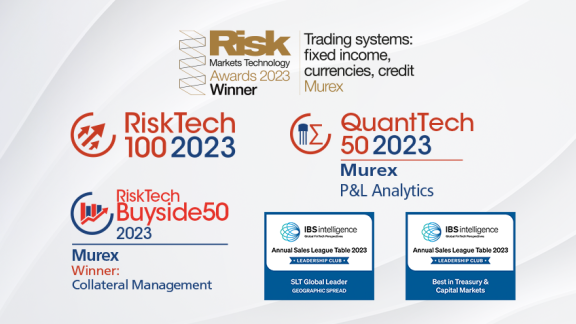-
Our solutions

Vote for us in the following categories:
Vote for us!
20. Best Professional Services Provider
30. Service Provider of the Year
31. Software Solution of the Year- Our clients

With 300 clients and 60,000 users spread across 60 countries around the world, Murex has a truly international client base of capital markets participants.
view all case studies- Insights
- Who we are

Our awards highlight a strong level of customer satisfaction and acknowledge our market expertise.
Visit our awards webpage- Our partners
- Careers
Murex FX Options Product Spotlight: Modeling Capacity
Fully integrated models manage two key client concerns: cost and risk reduction
by Ludovic Moulins, Murex FX Options Product Manager
In the previous article in this series, we homed in on FX options real-time portfolio management functionality and highlighted trader advantages of uniform data representation. We focused on its capacity to account for, manage and support increasingly complex and rigorous pricing models, which are an important function and capability for traders.
In this post, we will focus on the importance of state-of-the art models to traders. The advanced risk modeling we will describe includes local volatility and stochastic local volatility (SLV) models.
Effective management of two particular, key areas of concern for our customers is paramount. One is cost—full integration drives cost reduction. The other, significantly, is risk—full integration reduces the risks posed by divergent models and behavior.
Let’s share some background on some relevant models for traders:
• SLV models are a mixture of local volatility and stochastic volatility models. They allow for the control of spot-vol dynamics and match real market behavior, striking the right balance between both models’ dynamics.
• The solution also features a local volatility model used by Murex clients, which allows traders to price and manage FX products with a simpler and computationally lighter approach.
Both models are powered by graphics processing units (GPUs), which accelerate Monte Carlo computations when they are relevant instead of Partial Differential Equations (PDEs). This drives both computation speed and accuracy.
The “Tremor” SLV models, it should be said, are competing with Tier 1 market makers on first- and second-generation exotics, allowing the many banks that have been using these models in production for several years to gain market share by actively trading deals.
Combined with Murex’s real-time portfolio management advances, MX.3 models enable traders to manage books using precisely the same assumptions as the ones used to quote exotics to their clients and inter-bank counterparties. What does this give the trader? It provides unvarying consistency, allowing banks that use the model to warehouse risk on such models. This, in turn, enables margin enhancement.
Available to both the front office and the market risk department, the model is compliant with the latest regulations.
Clients who could use the models see an expanding exotic business. These clients require the SLV model to risk-manage and price books. Banks and financial institutions that want to break into this space stand to benefit from an ability to manage more complex structured products.
The trading desk relies on model quality. In that respect, Murex’s offering meets the most advanced standards and market practices, approaching a near perfect volatility curve fit and very stable calibration, among other features. MX.3 for Analytics Validation is a packaged model validation offering that allows banks to adopt models quickly because of an enhanced level of automation and a series of packaged tests.
The initial validation can additionally be facilitated by an internal quant or an external support team. It does greatly reduce the cost of periodic re-validation of models as well as continuous monitoring of model behavior in production. With this solution, Murex provides the tools and methodology to decrease the model validation costs of producing an integrated and automated validation framework, removing the need for the client to do it on their own.
There is a wide community that can benefit from Murex models and their validation solution, including:
• Banks willing to launch new business lines, including first- and second-generation exotic FX options, both with quoting and management position views.
• Banks willing to start quoting competitive prices on first- and second-generation exotic FX options.
• Banks that already have small business on first- and second-generation exotic FX options in back-to-back mode and that are willing to internalize the risk to augment margins. This customer community includes the banks described above.
• Hedge funds willing to use a more accurate pricing model as a positions benchmark against banking counterparties.
In the next article in this series, we will examine the importance of both a deep, wide product catalog and lifecycle management.
You might be interested in ...
- Video
Sabine Farhat Discusses Integrated Platform Benefits at ICMA FinTech and Digitalisation Forum
Watch the video- Article
Preparing Clients for LIBOR Discontinuation Scope and Challenges: Part 2 of a Murex Experts Q&A
Read more- Article
Preparing Clients for LIBOR Discontinuation Scope and Challenges: Part 1 of a Murex Experts Q&A
Read more- Video
Murex's Sabine Farhat Highlights Solution to Navigate Changing Securities Finance Landscape
Watch the video - Our clients


